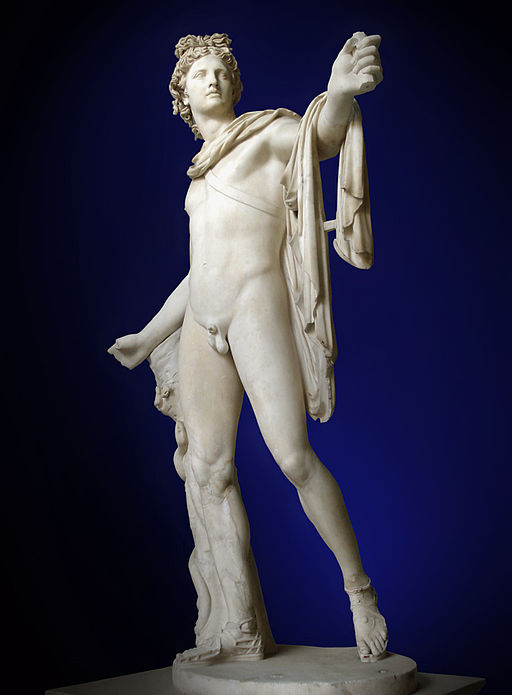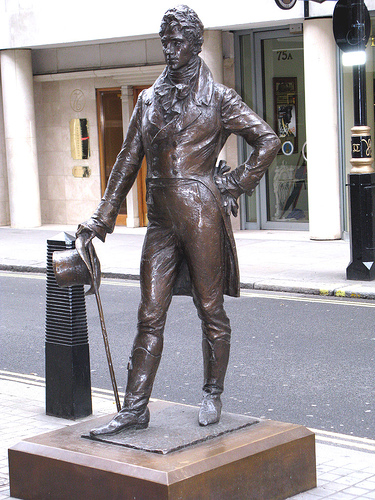Much is often made of Beau Brummell’s unique and lasting contributions to fashion, but in the interest of citing one’s sources, it’s important to clarify just exactly who — or what — old George was modeling himself on.
Because just around the time that a young George Brummell was setting up house at 4 Chesterfield Street in Mayfair, the Apollo Belvedere had just made its way to London for exhibit, having been recently looted from Rome by that noted art appreciator and collector Napoleon Bonaparte in 1796.
It wasn’t the first time London had laid eyes on this Apollo, of course. This sculpture had been copied and revered for hundreds of years as the pinnacle of classical beauty. Casts and sketches of it littered virtually every artist’s studio and museum, and it wasn’t uncommon for English gentlemen of wealth and status to have themselves painted in the same pose.
But the mania for all things classical had now taken hold in a way it never had before. Everything from home decor to ladies’ muslin dresses were modelled on the classical ideal.
So the time was ripe for the allure of Apollo to hold sway over one very influential young man. And through him, the rest of the fashionable world.
The similarity of George Brummell’s features and build to that of the most famous statue in classical antiquity was remarked on at once by Brummell’s fawning admirers.
A friend sighed:
Nature had indeed been most liberal to him… he was about the same height as Apollo and the just proportions of his form were remarkable… and, had he been inclined to earn his livelihood… he would readily have found an engagement as a life sitter to an artist, or got paid to perambulate… from fair to fair, to personate the statues of the ancients.
Brummell, it should be noted, did absolutely everything he could to encourage the comparison.
Brummell set a new standard for fashion, and it’s sad that the passing of time has given him and his “dandy set” such a bad rap. Because rather than persist in the Rococo excesses of their fathers and grandfathers, Beau and his gang tossed aside wigs and powder, silk and velvet, all in favor of a far more restrained mode of dress.
Somber colors. Simple linen. Impeccable tailoring. Tight fit.
In particular, the style of trousers favored by the Beau and his set was meant specifically to emulate the classical form found in art such as the Apollo Belvedere. Even the creamy pale shade of fabric they favored for their trousers, which was framed so starkly by a dark, cutaway jacket and polished Hessian boots, was meant to evoke the smooth paleness of marble.
In short, the goal was to appear, as near as possible, quite naked from the waist down.
Not surprisingly, this new fashion led to the wholesale jettisoning of the undergarments, or “small clothes” on the part of this set of fashionable young men. Since the goal was to appear to have a form as smooth and idealized as a classical Greek sculpture, one could hardly allow this vision of loveliness to be broken up by something as outré as a pantyline.
No supporting underclothes beneath pale, tight trousers, of course, meant that suddenly the public eye was quite firmly fixed on a young man’s, ah, princely estate. And there were few secrets that went unrevealed, shall we say. Not since the codpiece of Tudor days had the joining of the male thighs been so much the focus of sartorial splendor.
It’s even been suggested that the approving phrase “a fine turn of the leg,” popular in novels and plays of the time as an appreciative comment on the male form, was to be understood euphemistically.
If you catch my drift.
It will perhaps not surprise you to discover that Lord Byron was a particular fan of the rise, so to speak, of this new mode of dress, and he did his utmost to champion it. And Byron was just as cognizant as any of the relationship of the new style to that of classical figures like the Apollo.
His praise for the Apollo was unstinting. He even suggested that by the creation of this one marble sculpture, humanity had discharged the debt we owed to Prometheus for the gift of fire.
And if it be Prometheus stole from Heaven
The fire which we endure, it was repaid
By him to whom the energy was given
Which this poetic marble hath array’d
With an eternal glory–which, if made
By human hands, is not of human thought;
And Time himself hath hallowed it, nor laid
One ringlet in the dust–nor hath it caught
A tinge of years, but breathes the flame with which ’twas wrought.
– Childe Harold’s Pilgrimage, IV, CLXIII, 161-163; 1459–67
Sadly, Brummell did not enjoy the nearly unlimited resources of his friend Lord Byron, and would soon find himself hounded out of London society. Riddled with debt, spurned by his old patron the Prince Regent, and already suffering from the syphilis that would eventually kill him, he fled for France in 1816, just seventeen years after beginning his glittering career as a center of fashionable London life.
By then, of course, Napoleon had fallen for the last time at Waterloo, and the Apollo Belvedere was returned to the Vatican where it remains to this day. The generation that followed — including influential critic John Ruskin and others — would turn on the ideals of Brummell’s day, disparaging the lofty formality of Apollo’s classical lines. Mind you, this is the Victorian crowd that brought back the fig leaf, among other dubious artistic innovations.
But the old style was not to disappear without regret. We hear that the ladies particularly lamented the passing of the pale, tight, pantyless trousers.
For it was said that in those days “one could always tell what a young man was thinking.”
Indeed.
Beth Dunn is a novelist, blogger, and geek. She writes at An Accomplished Young Lady and contemplates the trousers of 19th century gentlemen just a little bit more than is entirely seemly. Even for a romance novelist.
To read more about Beau Brummell’s life and contributions to fashion, get your hands on the excellent biography of Brummell by Ian Kelly, The Ultimate Man of Style, to which this article owes much. Including, one imagines, an apology.


